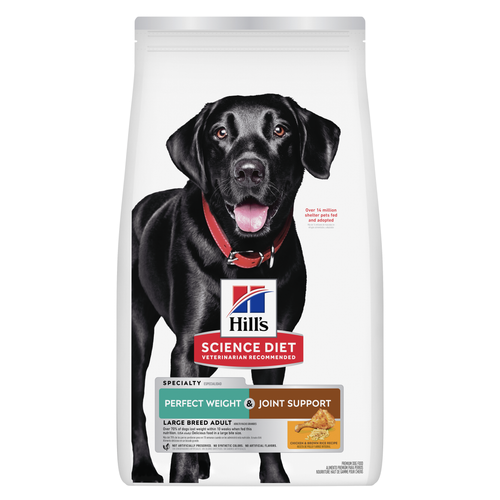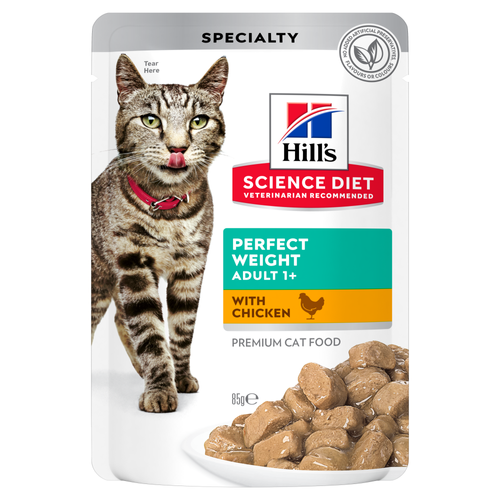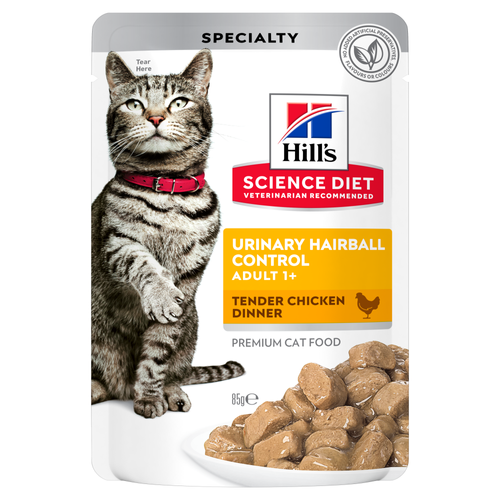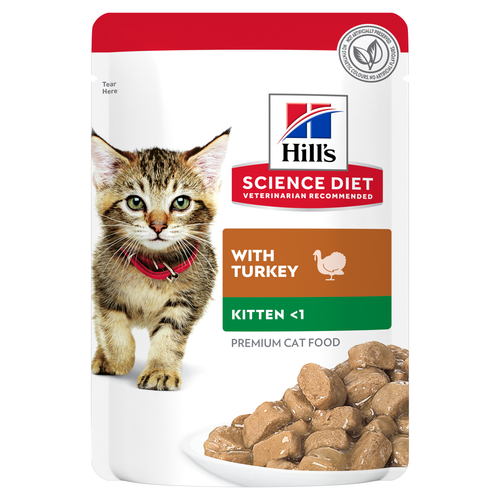
-
Find the right food for your petTake this quiz to see which food may be the best for your furry friend.Find the right food for your petTake this quiz to see which food may be the best for your furry friend.Health CategoryFeatured products
 Perfect Weight & Joint Support Large Breed Chicken & Brown Rice Recipe Dog Food
Perfect Weight & Joint Support Large Breed Chicken & Brown Rice Recipe Dog FoodThis weight management and mobility support dog food was created with Hill’s unique understanding of the biology of overweight dogs
Shop Now Adult Salmon & Brown Rice Recipe Dog Food
Adult Salmon & Brown Rice Recipe Dog FoodSupports lean muscle and beautiful coat for adult dogs
Shop Now Adult 7+ Healthy Cuisine Roasted Chicken, Carrots & Spinach Stew Dog Food
Adult 7+ Healthy Cuisine Roasted Chicken, Carrots & Spinach Stew Dog FoodDelicious roasted chicken paired with tender vegetables in a succulent stew
Shop NowFeatured products Adult Perfect Weight with Chicken Cat Food
Adult Perfect Weight with Chicken Cat FoodBreakthrough nutrition for your cat’s healthy weight maintenance and long-lasting weight support
Shop Now Adult Urinary Hairball Control Tender Chicken Dinner Cat Food
Adult Urinary Hairball Control Tender Chicken Dinner Cat FoodPrecisely balanced nutrition to support urinary health from kidney to bladder. With natural fibre technology to help reduce hairballs.
Shop Now Adult Salmon & Brown Rice Recipe Cat Food
Adult Salmon & Brown Rice Recipe Cat FoodSupports lean muscle and beautiful fur for adult cats
Shop Now -
DogCat
- Cat Tips & Articles
-
Health Category
- Weight
- Skin & Food Sensitivities
- Urinary
- Digestive
- Kidney
- Dental
- Serious Illness
-
Life Stage
- Kitten Nutrition
- Adult Nutrition
Featured articles Water
WaterWater is the most important nutrient of all and essential for life. Animals can lose almost all their fat and half their protein and still survive, but if they lose 15% of their water, it will mean death.
Read More Pet Food Storage Tips
Pet Food Storage TipsWhere you store your cat and dog food can make a big difference in the quality and freshness once it is opened. Here are some common questions and recommendations for optimal storage for all of Hill’s dry and canned cat and dog food.
Read More The Right Diet For Your Pet
The Right Diet For Your PetLearn what to look for in healthy pet food & nutrition, including ingredients, quality of the manufacturer, your pet's age, and any special needs they have.
Read More -


Visit any grocery store aisle and you are certain to find more and more shoppers scanning labels to make sure their food is "free" of one thing or another: gluten free, fat free, sugar free… the list grows longer each day. Now, these preferences have extended beyond the dinner table and into the food bowl, as discerning pet parents strive to make similar food choices for their beloved four-legged family members. After all, who doesn’t want their furry friend to have a healthy and happy life?
It’s no wonder that the pet food market has reacted in kind, with an array of grain-free cat food options appearing within the recent years. But is grain-free food for cats the right option for your favorite kitty? Contrary to what can be found on the internet (which is anything), grains can actually be good for your cat. Here are answers to some of the most common questions about grain-free cat food — and whether you should consider for your own pet.
What Is grain-free cat food?
Grain-free cat food is just what its name describes — a cat food made free of grains. Common grains found in cat food include wheat, corn, oats, barley and rice.

Most cats don't require a grain-free food and cats with diagnosed grain allergies are unusual. In a study published in Veterinary Dermatology, corn was found to be one of the least likely sources of food allergy in a cat. Of the 56 cats in the study with food allergies, corn was responsible for four cases of allergy issues. Forty-five cats, meanwhile, suffered from allergies associated with eating beef, dairy and/or fish. So how can you know if your cat has a food allergy? Some possible signs of a food allergy include:
- Itchiness
- Excessive grooming
- Excessive hair loss
- Bald patches
- Inflamed skin
- Sores and scabs
- "Hot spots"
Cats can have allergic reactions to grooming products, food and environmental irritants, such as pollen or flea bites which are more common than food allergies. Feline acne, mites, lice, and bacteria and fungus infections of the skin all can lead to similar signs as food allergies in your kitty. You can narrow down what type of allergy your cat has by having your vet do a thorough examination and if food is suspected, your vet may recommend an elimination trial, the gold standard for diagnosing a food allergy, that can help you determine what the cause of your cat's discomfort is. If there is ever a question, your vet should be your number one source for discovering if any allergies do exist.


Tasty Tips

Does grain free also mean gluten free and low carb?
More than 3 million Americans suffer from celiac disease, a painful condition that can be managed by following a gluten-free diet. But the good news is there is no scientific evidence that the same condition affects cats. So, avoiding gluten is not necessary for cats.
What many pet parents forget to consider is that to replace grains, grain-free food often uses ingredients such as potatoes, sweet potatoes, tapioca, lentils and peas. In fact, some grain-free pet foods contain carbohydrate levels similar to or even higher than cat food containing grains — but carbs don’t make dogs and cats fat. A sedentary lifestyle, neutering, over-feeding, feeding table scraps, consuming too much fat and calories are risk factors for obesity rather than carbohydrates. Carbohydrates from whole grains help provide your kitty with complete and balanced nutrition — the key to good health.
Are grain-free cat foods high in protein?
Protein is especially important in cat food because, unlike many other animals, protein is a cat's primary energy source. What many people don't realize (57 percent of cat parents, according to a PetMD survey) is that while cats do require a part of their protein to come from animals, their systems are also very good at digesting and absorbing nutrients from high-quality, plant-based ingredients. Carbs help protect the muscles in the body, especially for cats. Providing adequate carbohydrate calories spares body proteins, like muscles, from being broken down to be used for energy.
In fact, a food that relies solely on meat as a protein source can be higher in phosphorous. While phosphorus is an essential nutrient, there is a link between high-phosphorus foods and a progression of kidney disease in cats and dogs. Vegetables and grains are low-phosphorus sources of essential amino acids that cats need, providing your cat with a source of protein she needs to be healthy.
How to find the right grain-free Food for your cat
Research the different options available for your cat, talk to your veterinarian, then choose a high-quality food that meets all the nutrients your cat requires (and that your cat actually likes to eat). Your diligence will go a long way to ensuring your cat's health now and long into the future.
Related products

Supports lean muscle and beautiful fur for adult cats

Breakthrough nutrition for your cat’s healthy weight maintenance and long-lasting weight support

Precisely balanced nutrition to support urinary health from kidney to bladder. With natural fibre technology to help reduce hairballs.

Delicious turkey chunks in gravy with omega-3 fatty acids for eye health and brain development in kittens, and high-quality protein to support muscle growth. Balanced levels of minerals for strong bones and teeth.
Related articles

Being overweight puts a cat at risk for developing many serious health issues. Weight gain indicates an increase in body fat and usually results when your cat eats too much and exercises too little.

As a responsible pet owner you owe it to yourself and your cat to understand problems associated with overweight cats.

Get helpful information on proper feline oral healthcare and why it's so vital to take care of your cat's teeth.

HillsPet Nutrition provides information on proper nutrition, fitness and special needs in keeping your cat healthy and happy.

Put your cat on a diet without them knowing
Our low calorie formula helps you control your cat's weight. It's packed with high-quality protein for building lean muscles, and made with purposeful ingredients for a flavorful, nutritious meal. Clinically proven antioxidants, Vitamin C+E, help promote a healthy immune system.
Put your cat on a diet without them knowing
Our low calorie formula helps you control your cat's weight. It's packed with high-quality protein for building lean muscles, and made with purposeful ingredients for a flavorful, nutritious meal. Clinically proven antioxidants, Vitamin C+E, help promote a healthy immune system.


